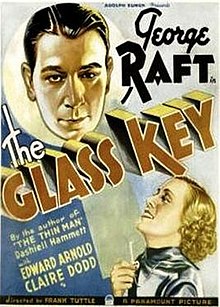The Glass Key (1935 film)
| The Glass Key | |
|---|---|
 Theatrical release poster | |
| Directed by | Frank Tuttle |
| Written by | Kathryn Scola Kubec Glasmon (screenplay) Harry Ruskin (additional dialogue) |
| Produced by | E. Lloyd Sheldon |
| Starring | George Raft Edward Arnold Claire Dodd |
| Cinematography | Henry Sharp |
| Edited by | Hugh Bennett |
| Distributed by | Paramount Pictures |
Release date |
|
Running time | 80 minutes |
| Country | United States |
| Language | English |
The Glass Key is the first of two film adaptations of the classic suspense novel The Glass Key by Dashiell Hammett. The film was released in 1935 starring George Raft, featuring Edward Arnold and Claire Dodd, and directed by Frank Tuttle.
The film was remade in 1942, with Alan Ladd in Raft's role, and Brian Donlevy and Veronica Lake in the roles previously played by Arnold and Dodd.
Plot
Paul Madvig (Edward Arnold) controls crime and politics in the city, helped by the brains and brawn of Ed Beaumont (George Raft). As he throws his support behind Janet (Claire Dodd) Henry's father in a political campaign, Paul also plans to marry her.
Janet's brother Taylor (Ray Milland) is a gambler heavily in debt to O'Rory (Robert Gleckler), a gangster whose club Paul intends to put out of business. Taylor, who has been romancing Paul's younger sister Opal (Rosalind Keith), is found dead. The temperamental Paul falls under suspicion.
Ed pretends to betray Paul while offering to work for O'Rory's organization. He is beaten by Jeff (Guinn Williams), a brutal thug who works for O'Rory, and has to flee for his life.
Paul is going to face murder charges, but Janet knows who is really behind her brother's death. It's up to Ed to get her to reveal the truth.
Cast
- George Raft as Ed Beaumont
- Edward Arnold as Paul Madvig
- Claire Dodd as Janet Henry
- Rosalind Keith as Opal Madvig (as Rosalind Culli)
- Charles Richman as Senator John T. Henry
- Robert Gleckler as Shad O'Rory
- Guinn Williams as Jeff
- Ray Milland as Taylor Henry
- Tammany Young as Clarkie
- Emma Dunn as Mom Madvig
- Charles C. Wilson as District Attorney Edward J. Farr
Reception
Writing for The Spectator, Graham Greene described the film as "unimaginatively gangster" and grouped it with the contemporary comedy No More Ladies to describe both as "second rate" and "transient".[1] Nevertheless, the film became one of Raft's biggest box office hits of the 1930s.[2]
References
- ^ Greene, Graham (5 July 1935). "The Bride of Frankenstein/The Glass Key/No More Ladies/Abyssinia". The Spectator. (reprinted in: John Russel, Taylor, ed. (1980). The Pleasure Dome. p. 6. ISBN 0192812866.)
- ^ Everett Aaker, The Films of George Raft, McFarland & Company, 2013 p 60
External links
- The Glass Key at the TCM Movie Database
- The Glass Key at IMDb
- The Glass Key at AllMovie
- The Glass Key at the American Film Institute Catalog
- The Glass Key film clip on YouTube
